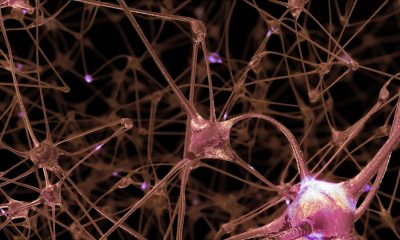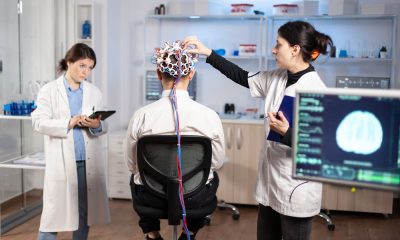Technology
3D-printed implants offer new hope for type 1 diabetes

Scientists have created 3D-printed devices containing insulin-producing cells that could offer long-term treatment for type 1 diabetes without the need for invasive surgery.
The small implants, designed to be placed just under the skin, would allow people with type 1 diabetes to produce their own insulin, potentially reducing the need for daily injections and constant blood glucose monitoring.
Type 1 diabetes is an autoimmune condition in which the immune system destroys insulin-producing cells in the pancreas. This requires lifelong management, often involving insulin injections and dietary control.
Researchers at the Wake Forest Institute for Regenerative Medicine in North Carolina developed the devices using a “bioink” made from human pancreatic tissue and alginate – a carbohydrate derived from seaweed – mixed with live insulin-producing cells.
One current treatment involves transplanting islets – clusters of insulin-producing cells – into the liver via the portal vein. This is a major surgical procedure, and around half of the transplanted cells lose functionality quickly, often requiring repeat procedures.
Quentin Perrier at the Wake Forest Institute said: “Current practice is to inject these human islets through the portal vein into the liver.
“The higher the density [of islets], the smaller the size of the device you would need to plant in the patient.”
Perrier and his colleagues printed the islets into a porous grid designed to allow new blood vessels to grow into the structure and support cell survival.
Lab tests showed around 90 per cent of the cells remained alive and functional for up to three weeks.
Perrier said: “We put this bioink with the [human] islet into a syringe, and we print a special motif [with it].
The next challenge is really to validate this finding in vivo.”
A parallel project by Adam Feinberg at Carnegie Mellon University in Pennsylvania, working with the biotech firm FluidForm Bio in Massachusetts, uses a different method.
His team prints cells and collagen directly into a hydrogel polymer.
Feinberg explained: “Kind of like 3D printing inside of hair gel.
In laboratory mice with diabetes, the printed islets restored normal blood glucose levels for up to six months.
Placing islets under the skin rather than in the liver could reduce surgical risk and avoid inflammation triggered by liver-based implantation, which can shorten cell lifespan.
The approach may also make treatment more accessible.
Feinberg described Perrier’s results as “definitely promising”, but pointed to a challenge with variability in the donor tissue used to create the islets.
Feinberg said: “It’s like getting a transplant organ.
“On one side, the material may work better. On the flip side, it’s variable and hard to get, and that’s a really hard problem to solve.”
Research
Night-time light exposure may increase stroke and heart attack risk

Bright light at night raises the risk of heart attack by 47 per cent and heart failure by 56 per cent, according to research involving nearly 89,000 people.
Being exposed to bright light at night could significantly increase the chances of developing serious heart problems, including heart attacks, strokes and heart failure.
The largest study of its kind tracked over 13 million hours of light exposure using wrist-worn sensors and followed participants for up to 9.5 years.
Those exposed to the brightest light at night were 56 per cent more likely to develop heart failure and 47 per cent more likely to suffer a heart attack. These risks remained high even after accounting for factors such as exercise, diet, sleep habits and genetics.
Researchers from Flinders University’s FHMRI Sleep Health analysed data from almost 89,000 people in the UK to investigate how personal light exposure affects heart health.
Dr Daniel Windred, lead author and research associate at Flinders University’s FHMRI Sleep Health, said the study highlights a risk factor many people overlook — one that is simple to address.
“This is the first large-scale study to show that simply being exposed to light at night is a strong and independent risk factor for heart disease,” said Dr Windred.
“Disrupting your body’s internal circadian clock by repeatedly exposing yourself to bright light at night, when it would typically be dark otherwise, will put you at a higher risk of developing dangerous heart issues.
“Thankfully, we do have some control over our exposure to light at night.
“By using blackout curtains, dimming lights, and avoiding screens before bed, we can help to reduce the health risks associated with light at night.”
The study also found that women and younger people were especially vulnerable to the effects of light exposure at night.
“Women may be more sensitive to the effects of light disrupting their body clock, which supports earlier research findings,” said senior co-author Professor Sean Cain.
“In fact, women exposed to high levels of night light had similar heart failure risks to men, which is unusual because women typically have some natural protection against heart disease.”
Everyday behaviours may also pose risks, added senior co-author Associate Professor Andrew Phillips.
“Everyday habits, like scrolling on your phone in bed or falling asleep with the TV on or bedroom lights on, can expose you to potentially harmful levels of light,” said Associate Professor Phillips from FHMRI Sleep Health.
“We’re not talking about extreme cases — even low levels of indoor light can interfere with your body’s natural rhythm.”
Unlike previous studies that relied on satellite images or surveys of outdoor light at night, this research used real-time data from wearable devices, providing a clearer picture of how indoor light environments affect health.
The circadian clock — the body’s internal timing system — regulates sleep-wake cycles and other biological processes over about 24 hours.
With heart disease still the leading cause of death worldwide, the researchers say it is time to treat light at night as a health risk, alongside poor diet, lack of exercise and smoking.
The team is calling for more research into lighting guidelines for homes, hospitals and cities to help reduce night-time light exposure.
“We need to take our body clocks seriously,” said Professor Cain.
“Protecting our natural sleep rhythms could be a powerful way to fight heart disease.”
Wellness
Researchers find new drug extends lifespan

Researchers have shown that new TOR inhibitor rapalink-1 prolongs lifespan in fission yeast, offering insight into how drugs may slow ageing.
Rapalink-1, a next-generation TOR inhibitor currently under investigation for cancer therapy, slowed cell growth and significantly extended lifespan in yeast models, acting through TORC1 — the growth-promoting arm of the TOR pathway.
The TOR (Target of Rapamycin) pathway is active in both yeast and humans.
It is a central regulator of growth and ageing and plays a major role in age-related diseases including cancer and neurodegeneration. Drugs such as rapamycin have already shown promise in extending healthy lifespan in animals.
The study also revealed a crucial role for enzymes called agmatinases, which break down the metabolite agmatine into compounds known as polyamines. These enzymes are part of a previously unknown “metabolic feedback loop” that regulates TOR activity.
When agmatinase function was lost, cells grew faster but aged prematurely, showing a trade-off between short-term growth and long-term survival. Supplementing yeast with agmatine or putrescine — compounds linked to this pathway — also promoted longevity and improved cell health under certain conditions.
“By showing that agmatinases are essential for healthy ageing, we’ve uncovered a new layer of metabolic control over TOR — one that may be conserved in humans,” said Dr Charalampos Rallis.
“Because agmatine is produced by diet and gut microbes, this work may help explain how nutrition and the microbiome influence ageing.”
Dr Rallis noted that agmatine supplements are available but urged caution.
He said: “We should be cautious about consuming agmatine for growth or longevity purposes.
“Our data indicate the agmatine supplementation can be beneficial for growth only when certain metabolic pathways related to arginine breakdown are intact.
“In addition, agmatine does not always promote beneficial effects as it can contribute to certain pathologies.”
The findings have broad implications for research into healthy ageing, cancer biology and metabolic disease, pointing to new strategies that could combine TOR-targeting drugs with dietary or microbial interventions.
News
Study reveals why “risk gene” causes Alzheimer’s

Researchers in Denmark have discovered why the APOE4 gene increases Alzheimer’s risk — by preventing brain cells from switching from glucose to fats for energy as they age.
The study found that as brain cells grow older and lose efficiency in using glucose — their main energy source — they can normally switch to burning lipids (fats) to survive. The APOE4 variant, however, blocks this crucial process.
Using transgenic mouse models and stem-cell-derived human brain cells, researchers found that APOE4 blocks the receptor on nerve cells responsible for lipid uptake, preventing access to this alternative fuel source.
Professor Thomas Willnow from the department of biomedicine at Aarhus University said: “The ability to use glucose diminishes in the ageing brain, forcing nerve cells to use alternative sources for energy production. Our research now documents that this alternative energy source is lipids.
“By using transgenic mouse models and stem-cell-derived human brain cell models, we uncovered that the pathway enabling nerve cells to burn lipids for energy production doesn’t work with APOE4, because this APOE variant blocks the receptor on nerve cells required for lipid uptake.”
Around 163 million people globally carry two copies of APOE4, with about 24 per cent of the world’s population carrying at least one copy.
The gene gained wider public attention when actor Chris Hemsworth revealed he carries the variant.
Willnow said: “Our research shows that the brain is highly dependent on being able to switch from glucose to lipids as we age. So those individuals who are carriers of the APOE4 gene variant – which seems to inhibit that ability – are naturally at a much higher risk.”
However, he urged carriers not to panic, noting that having the gene increases the likelihood of developing Alzheimer’s but does not make it inevitable.
“First of all, being a carrier of the gene heightens the risk but does not equal developing Alzheimer’s. One thing we can all do is live healthier.
“We know that a healthy body, to a large extent, equals a healthy brain. Although not proven in patients yet, our data also suggest that providing more healthy lipids for the cells to thrive – especially poly-unsaturated fatty acids in vegetable or fish oil – may help. Even cells that work poorly will function better when given more fuel.”
The discovery could lead to new treatment options, potentially by repurposing existing drugs that target how the body utilises lipids.
Willnow said: “Now that we know why this decrease in brain health happens, we can start to look at how to prevent or delay it.
“There are already drugs on the market that specifically target the body’s ability to utilise lipids – it might be that one of those drugs can actually be used in the treatment, or even prevention, of Alzheimer’s. I am very hopeful that might be the case.”
The team now plans proof-of-concept studies using human-derived cell models from stem cells.

 Research2 months ago
Research2 months agoBusiness roundup: Grant to advance mitochondrial biomarker research

 News1 month ago
News1 month agoStudy finds link between circadian rhythms and bone resorption

 News2 days ago
News2 days agoJust 30 mins of light activity can boost energy and mood, study finds

 Research2 months ago
Research2 months agoDifficulty reading faces could be early warning sign of dementia, researchers say

 News3 weeks ago
News3 weeks agoGlasgow clinic launches Alzheimer’s detection test

 News1 month ago
News1 month agoNHS dementia staff say patients missing out on best care as diagnosis system falls short

 News2 weeks ago
News2 weeks agoRoundup: Atlas maps molecular fingerprints of health, disease and ageing

 Insights2 months ago
Insights2 months agoQuick test could identify Alzheimer’s risk long before symptoms show































